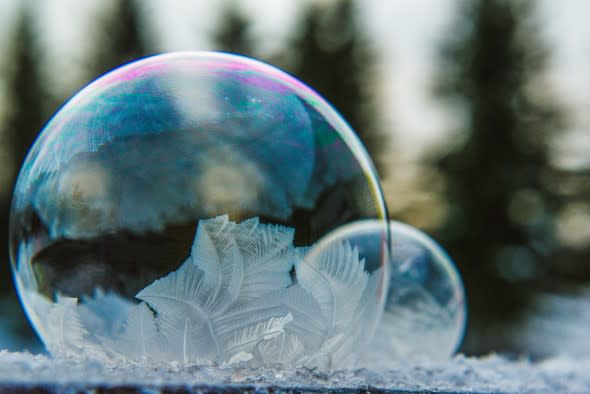From blowing frozen bubbles to throwing boiling water: Here's the science behind these viral cold-weather experiments
The polar vortex swept through the midwestern and northeastern United States at the end of January, bringing with it some of the coldest weather that the region had endured in decades.
While the cold weather deterred many from going outside, others took advantage of the freezing temperatures and tested out different science experiments.
Experiments ranged from blowing frozen bubbles to throwing boiling water to tossing cracked eggs.
Before venturing out to test an experiment, make sure to always dress appropriately for the conditions to limit the risk of frostbite or hypothermia.

(Thinkstock/iStock/raigna)
The boiling water trick
The boiling water trick was one of the more popular experiments on social media. As experimenters threw steaming water, a white cloud was left behind.
"The boiling water starts off mostly in the liquid phase. However, since it's so hot and the water droplets are much smaller, it evaporates or transitions to water vapor faster than cool water, which is why this trick works better with boiling water," AccuWeather Senior Meteorologist Jason Nicholls said.
A couple of things occur when the boiling water is thrown into the air.
"First, the hot water is making water vapor through evaporation. Second, the water breaks into smaller globs of water as it passes through the air. Both the evaporation and the smaller blobs mean that the water will cool off quickly," Nicholls said.
On top of that, cold air can't hold much water vapor. Thus the water vapor doesn't stay in the air as it condenses out, giving you the cloud of ice crystals you see.
In order to achieve this white cloud, the air must be cold, as well as dry with very low relative humidity, ideally below 25 percent. The experiment works best at temperatures below zero F.
When conducting this experiment, safety is paramount. It is important not to throw the boiling water over your head or toward other people and pets.
"Also watch the wind direction, as any hot water that fails to instantly evaporate could land on you or someone else. It could be hot enough to cause burns," Nicholls said.
During the recent polar vortex, at least eight people in Illinois ended up in the hospital after their attempt at performing the boiling water trick went awry, the Chicago Sun-Times reported.
So it's a bit chilly in #Chicago Feel free to use, @accuweather @ABC7Chicago #polarvortex #deepfreeze #chicago #windchill #freezing #brrrr pic.twitter.com/7BjhuBI6y4
— jordanwilson04 (@jordanwilson04) January 30, 2019
The classic brutal sub-zero weather experiment at my Minneapolis home - boiling water freezes in seconds @wcco has the latest on this polar vortex plunge - stay warm and stay safe ! pic.twitter.com/gQJglgAG0f
— esme murphy (@esmemurphy) January 29, 2019
The boiling water trick can also be done using a water gun:
Boiling water. SuperSoaker. Oven mitts. Let's go. #polarvortex pic.twitter.com/xLf8H0wqD4
— A Scribe Called Quest (@StarrburyMike) January 30, 2019
The frozen bubble experiment
Seemingly magical videos appeared online of frozen bubbles, demonstrating how a normally ethereal soap bubble hardens into a lacy globe when the temperature is right.
Bubbles are like a "water and soap sandwich," with soap encasing a layer of water. In warmer weather, the air inside the bubble expands as it warms, popping the bubble before it gets far. But in cold weather, the water sandwiched inside the soap has a chance to freeze before the bubble pops.
As soon as you touch them, however, the heat from your fingers will melt the bubble.
This experiment can be tested with different solutions to create the longest-lasting bubbles. Many people add glycerin, which gives the bubbles strength, according to Scientific American.
Just another day in Northern Alberta playing around with frozen bubbles in the cold winter temperatures #travelalberta #yeg pic.twitter.com/XnKcgpFwCw
— Lea St John (@LaPetiteWatson) February 2, 2019
Freezing bubbles this morning! #frozenbubbles pic.twitter.com/7OKanG2DPc
— Matt Standridge (@5NEWSMatt) January 30, 2019
Freezing various items
Many of the experiments posted on social media during the polar vortex involved freezing various objects, ranging from eggs to wet clothes to even wet hair.
The egg trick, which often involves cracking an egg on a pan outside, was one of the many experiments that people tested during the recent polar vortex.
Social media users would go out and time how long it would take the egg to freeze solid.
— a bat eating fruit (@tinybeepbeep) January 30, 2019
Other social media users would go outside with wet hair and watch it freeze atop their heads.
"Is Iowa really THAT cold?" pic.twitter.com/htxSZzy2QB
— Taylor Scallon (@taylor_scallon) January 31, 2019
Frozen clothes were also among the items that were tested during the recent polar vortex:
How cold is it? @matthewkirkwood shows a Football Frenzy t-shirt FROZEN SOLID in minutes! #earlyclub #wmiwx #news8 pic.twitter.com/Qw7AHimBAc
— Terri DeBoer (@terrideboer) January 6, 2014
The balloon trick
The balloon trick is designed to show how the volume of a gas expands as it warms, and contracts as it cools.
To do this, blow up balloons in warm air, then expose them to cold air and they will deflate. Eventually they will reinflate when you return them to warm air.
Should we challenge our @KHS_Chiefs & @KempsAcademy staff to explain (or try!) a science experiment? @ms_teed @CaitlinStravino @KarenZahr @5bostonfans @QuicheRae @DrewMidgette @khssca https://t.co/AU9q35jGam
— Gabriel Hyde Wetmore (@Gabriel_Wetmore) February 2, 2019
Meanwhile, other social media users filled up balloons with water and food coloring. The balloon would then be left outside overnight in freezing temperatures in order to create beautiful sculpture-like art.
Helpful reminder that if you are experiencing super-cold temps, it's pretty important that you fill a balloon with water and food coloring and leave it outdoors overnight. pic.twitter.com/6tLfmG0sOL
— Eileen Webb (@webmeadow) January 30, 2019

